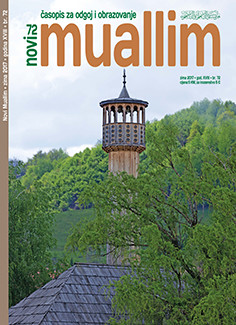AIŠA BINT EBI BEKR KAO PARADIGMA ŽENE MEDINSKOG DRUŠTVA
(jedan pogled na feminističku misao Fatime Mernissi)
DOI:
https://doi.org/10.26340/muallim.v18i72.1617Ključne riječi:
islamski feminizam, sekularni feminizam, hadis, medinsko društvo, medinska demokratijaSažetak
UDK 141.72:28
Islamski feminizam stoji na stanovištu da nije islam onaj koji uskraćuje prava ženama, nego muslimani muškarci, te stoga s nadom gleda u medinsko doba kao primjer idealnog muslimanskog društva i demokratije. Unutar njega, pak, izdvojena je figura Aiše bint Ebi Bekr, supruge Muhammeda, a.s., kao paradigme društveno aktivne uloge muslimanke. Jedna od najpoznatijih feministkinja u muslimanskom svijetu, Fatima Mernissi, uzima upravo Aišu, r.a., za centralni lik knjige u kojoj izlaže svoje stavove o položaju muslimanke u prošlosti, istovremeno identifikujući principe na kojima je počivalo „idealno medinsko društvo“. Doprinos Mernissijeve tematici islamskog feminizma je originalan, budući da ona svoj stav pokušava objasniti klasičnim i tradicinalnim izvorima, baveći se pri tome ponajviše povodima objave kur'anskih ajeta, te hadisima. Pri tome, njena metodologija je vodi ka historizaciji svetog Teksta, a autor ovog rada smatra primjerenijom metodu kontekstualizacije islamskih principa, odnosno razumijevanju duha kur'anske legislative, a ne insistiranje na pojedinačnim šerijatskim odredbama (tragom Fazlur Rahmanovog razlučivanja između sunneta vjere i historijskog hadisa). Ipak, centralna ličnost Mernissijevih autorskih studija, Aiša bint Ebi Bekr, i oživljavanje njenog primjera jeste velika prilika za islamski feminizam, koji bi se morao hraniti duhom kur'anskim i poslaničkim, ukoliko želi osigurati svoj legitimitet u savremenim intelektualnim kretanjima muslimanskih društava.
Downloads
Objavljeno
How to Cite
Broj časopisa
Rubrika
License
Naknada:
a. Časopis ne naplaćuje naknadu za obradu članaka (APC) i naknadu za podnošenje članaka.
Autori koji objavljuju u ovom časopisu pristaju na sljedeće uvijete:
- Autori zadržavaju autorska prava i pružaju časopisu pravo prvog objavljivanja, pri čemu će rad jednu godinu po objavljivanju biti podložan licenci Creative Commons imenovanje koja omogućuje drugima da dijele rad uz uvijet navođenja autorstva i izvornog objavljivanja u ovom časopisu.
- Autori mogu izraditi zasebne, ugovorne aranžmane za ne-ekskluzivnu distribuciju rada objavljenog u časopisu (npr. postavljanje u institucionalni repozitorij ili objavljivanje u knjizi), uz navođenje da je rad izvorno objavljen u ovom časopisu.


